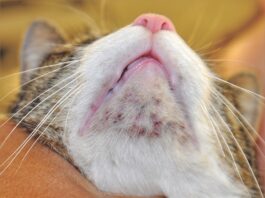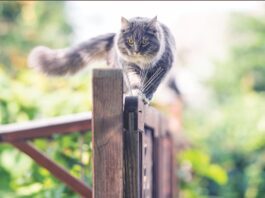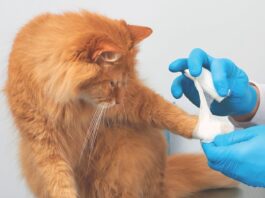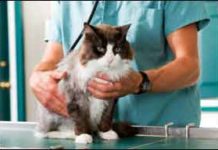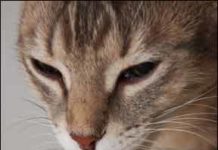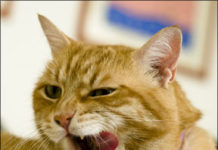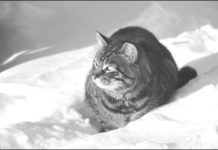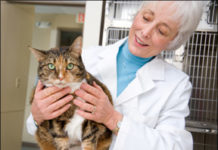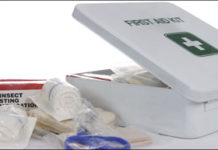Feline Blood Donors: Necessary
Blood can be the gift of life not just for us, but also for our cats. "A cat suffering severe injury or trauma may require blood transfusions," says Marjory Brooks, DVM, associate director of the coagulation section at Cornell Universitys Animal Health Diagnostic Laboratory. Other indications for transfusion include surgical complications and anemia caused by autoimmune disease, renal failure, chemotherapy, parasites in the intestinal tract or fleas. "Young kittens are especially at risk for blood-loss anemia caused by flea infestation," says Dr. Brooks. Cats that need plasma proteins to combat liver disease, clotting problems or rat poisoning may also require a transfusion.
Diagnosis: Conjunctivitis
Your cats eyes, like yours, are delicate structures made up of various components -the cornea, pupil, iris, lens, retina and so forth - each of which plays a role in enabling the animals keen vision. While the feline eye is generally sturdy and resistant to injuries and disease, a wide variety of disorders, such as glaucoma and cataracts, can impair a cats vision and even, in some cases, lead to blindness. According to Thomas Kern, DVM, an associate professor of ophthalmology at Cornell Universitys College of Veterinary Medicine, the most common of all feline eye disorders is conjunctivitis, an inflammation of the thin mucous membrane (conjunctiva) that lines the inner surface of the eyelids and coats the outer surface of the eyeball.
Emergency Care for Your Cat
Perhaps the most important characteristic of a responsible cat owner is the ability to distinguish the signs of minor feline illnesses from those calling for an immediate trip to the nearest animal emergency care facility. Cat owners should be equipped ahead of time to deal promptly with such a crisis. They should know precisely where the clinic is located, the speediest route to get there, how to transport the afflicted animal, what documents they should take to the facility - and what to expect to happen upon arrival.
Short Takes: February 2011
Multiple endocrine glandular failure is recognized in humans, yet it is an uncommonly recognized phenomenon in veterinary medicine. This retrospective study ("Multiple endocrine diseases in cats: 15 cases [1997-2008]," Journal of Feline Medicine & Surgery, 2010) included a population of cats from a university veterinary teaching hospital diagnosed with multiple endocrine disorders.
Can Acupuncture Help Your Pet?
Three or four decades ago, few cat owners or veterinary practitioners in the U.S. knew anything whatsoever about acupuncture, the centuries-old Chinese system of health care that aims to treat physical disorders and their accompanying pain by inserting needles into specific points on a patients body. Today, thousands of veterinarians throughout the nation routinely practice acupuncture in their clinics, and countless cats are benefiting from it. "Im certainly an acupuncture advocate," says Andrea Looney, DVM, a senior lecturer in anesthesiology at the Cornell University Hospital for Animals. "I use it in treating between 10 percent and 20 percent of the patients that I see - not only cats, but dogs, horses and other animals as well." Dr. Looney stresses that she relies on acupuncture as a complementary technique, always using it in conjunction with the standard practices of Western veterinary medicine.
Searching for Signs of Pain in Your Cat
Is there a clear way that we can tell that a cat is in pain? According to Andrea Looney, DVM, a senior lecturer in anesthesiology at the Cornell University Hospital for Animals, "We look at two categories of clinical signs - physiologic and behavioral. The physiologic signs include such indicators as heart rate, temperature, respiratory rate, blood pressure and the levels of certain stress hormones in the blood. "But these indicators are not as reliable as the behavioral signs," she continues. "Each cat is an individual, and we try to look at how they normally behave and how that behavior is different when they come in with complaints.
Short Takes: December 2010
Researchers developed a questionnaire for evaluation of cat owners perception of and knowledge about vaccination of cats, with owners asked to fill out a separate questionnaire for each cat they owned. A total of 3,163 questionnaires were evaluated ("Use of a web-based questionnaire to explore cat owners attitudes towards vaccination in cats," Veterinary Record, 2010). Vaccination as a kitten was the strongest predictor of up-to-date vaccination status, followed closely by plans to take the cat to a boarding cattery or cat show in the coming year. Owners who ranked the severity of infectious diseases or veterinary advice as very important were more likely to vaccinate their cats than owners who perceived these factors as less important.
Hypothermia: A Winter Danger
Cats whose breed developed in frigid areas of the world are likely to tolerate cold weather better than cats whose origins can be traced to more temperate regions. But even the fattest, furriest Maine Coon will have only a slight edge over a trim, thin-coated Siamese when it comes to prolonged exposure to the biting winds, ice, snow and sleet that come with winter. Indeed, any cat that is left outside for extended periods of time when the temperature is below freezing - not to mention any poor creature that happens to tumble into an ice-cold pond - will be at risk for a potentially deadly drop in body temperature.
Nasal Disease: Understand the Signs
Does your cat have a bad case of the sniffles? Its probably nothing to worry about. Just like you, your cat is apt to come down with a minor respiratory infection now and then, and it will pass. But if the runny nose that persists for more than a few days - and especially if the secretions thicken and become darker in color - you should take your pet to the veterinarian for an examination.
Get Some Relief for Your Arthritic Cat
The good news is that cats are living longer these days, thanks largely to advances in feline nutrition and veterinary medicine in general. The bad news, however, is that these longer life spans give cats a greater chance of developing arthritis - a painful, debilitating and potentially crippling joint disease that is predominantly age-related. All Too Common. In a study conducted a few years ago, researchers carefully analyzed X-rays of the spines and limbs of 100 middle-aged or elderly cats (10 years of age or older).
Sorting Out Elimination Disorders
Many serious feline conditions - some of them even life-threatening - commonly display themselves in the excessive passage of watery feces (diarrhea); the painful retention of dry, hardened feces (constipation); the frequent voiding of abnormally large amounts of urine (polyuria); or difficult, perhaps even impossible, urination (dysuria).
Feline First Aid: What To Do
All cats are prone to serious injury or the sudden onset of life-threatening clinical signs of deeply rooted and perhaps previously unrecognized illness. And the actions that an owner takes immediately after a cat has had an accident or is in obvious physical distress might save its life. Responsible cat owners should have a basic understanding of how to respond in case an emergency arises. But more important, says Richard Goldstein, DVM, associate professor of clinical sciences at Cornell Universitys College of Veterinary Medicine, is that owners know what not to do in such a situation, since inappropriate treatment can make a bad situation worse and can conceivably kill, rather than help, an ill or injured cat.


